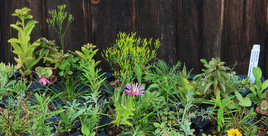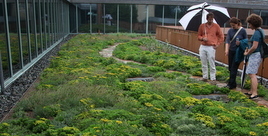Why A Green Roof?
Why have a green roof? There are many answers ranging from simply complying with stormwater regulations, to increasing biodiversity and wildlife habitat in an area, or creating outdoor space to benefit building residents.
A Green Roof should be designed with specific goals in mind. It can be costly to try to meet too many goals on any one site, although, with a little planning, more than one benefit can be achieved. When client expectations are considered early in the process, particularly with regard to plant options and desired roof maintenance, multiple benefits can be accomplished.
Benefits of a Green Roof:
Green Roofs can provide both public and private benefits, and include, but are not limited to, the following list:
- Stormwater Management – Green roofs help mitigate the problems caused by increased impermeable surfaces in built-up areas that change the natural flow of rainwater.
- Longer Life for the Roof Membrane – A green roof will protect the roof membrane from the damaging UV light of the sun. Instead of replacing a roof in 15 years, it may not need to be replaced for 30 years or more.
- Lower Energy Costs – If designed correctly, green roofs may reduce the heating and cooling costs of a building.
- Mitigation of the Urban Heat Island Effect – Heavily built urban areas store more heat than natural areas. This can cause public health and comfort issues as well as costly increased energy consumption. Green roofs can help reduce this effect.
- Biodiversity and habitat – Green roofs can increase biodiversity and create habitat in areas that are not usually hospitable to pollinators, birds, or other wildlife.
- Amenity and Aesthetics – Green roofs can provide outdoor space for city dwellers, or better views from other buildings, overlooking the roof. Studies show benefits to health and well-being, as well as increased productivity, from office workers with green roof access or views.


